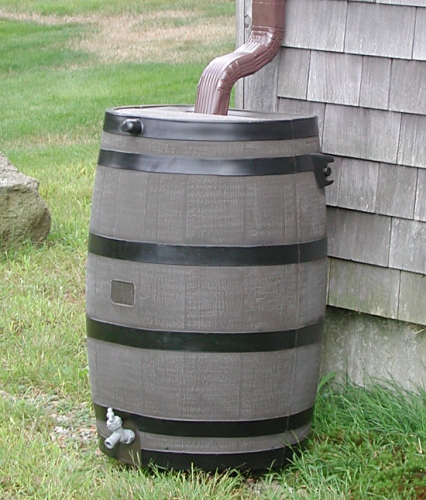Rain barrels are economical and ecological
Rain barrels can save money and energy for homeowners as they simultaneously reduce water quality pollution.
 April
showers bring May flowers. It also brings a lot of storm water runoff. Storm water runoff is water from rain or snow
melt that “runs off” across the land usually into the nearest stream, river or
lake instead of soaking into the ground. This water can be captured and used
around your home to reduce run off and your water bill.
April
showers bring May flowers. It also brings a lot of storm water runoff. Storm water runoff is water from rain or snow
melt that “runs off” across the land usually into the nearest stream, river or
lake instead of soaking into the ground. This water can be captured and used
around your home to reduce run off and your water bill.
How much water are we talking about? Nearly 40 percent of the average household’s water use during the summer months is for lawn and garden irrigation. There’s approximately six to seven gallons of water coming from an average hose every minute. To water a 1,000 square-foot lawn with one-inch of water per week uses 620 gallons of water. A rain barrel can save most homeowners around 1300 gallons of water during the peak summer months
What
is a Rain Barrel?
A rain barrel is a large container with a
top that a home’s downspout fits into and a spigot at the bottom to get the
water out for use. A rain barrel
collects rain water and stores it to use for watering plants or washing the
car. It contains no chlorine, lime or calcium which makes it beneficial for
gardens and potted flowers and plants.
How
does a rain barrel work?
When it rains, the water runs off the roof
into the gutters to the downspouts. A tenth of an inch of water running into a
20 foot linear gutter results in 45 gallons of water going to the downspout.
From the downspout, the water normally flows out and soaks into the grass or runs down the driveway to the nearest storm drain. Storm drains lead directly to the nearest surface water – a drain, creek, stream, river or lake. This storm water collects pollutants that contaminate the surface water it enters. A rain barrel is attached to the downspout and collects the water instead of it running onto the grass or driveway.
Where
do you put a rain barrel?
Determining the site for your rain barrel
will be based on a number of factors:
- Aesthetics: What does your barrel look like? Is it a 55 gallon plastic drum? Or is it a purchased decorative urn?
- Convenience: Is there a downspout near where the rain water will be used?
- Drainage: Does the ground around the selected downspout have good drainage? Is the area higher to allow for other rain water to run off the area?
- Obstacles: Are there trees in the area where you want to put the rain barrel? If leaves get into the rain barrel, it will produce smelly leaf leachate.
- Safety: Is the area level where the barrel will sit? Is it in an area accessible to children or pets? Remember one gallon of water weighs about eight pounds. A full rain barrel can weigh up to 500 pounds.
What
are the benefits of using a rain barrel?
In addition to saving water in the yard and
garden, rain barrels can save money, energy, protect the environment and
provide plants with untreated “soft water” free of dissolved salts or sediment.
If you pay a water bill, saving hundreds of gallon of water can significantly
reduce your bill. That reduction also
saves the energy needed to clean and process water for use on a lawn or
garden
Using a rain barrel will reduce the amount of storm water runoff into local community water systems which may reduce flooding and stress on the water system. It will improve the water quality of local lakes and rivers by reducing soil erosion and other pollutants that accumulate in the storm water runoff.
Rain barrels may be purchased or homemade. Check with local environmental organizations to see if they sponsor rain barrel sales or can direct you to a reputable distributor.



 Print
Print Email
Email




